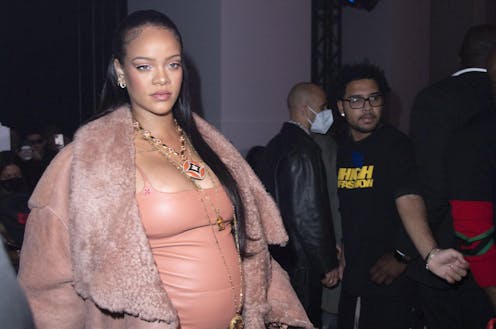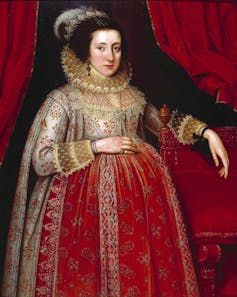
There is a stage in pregnancy where many women have to start thinking about switching out their clothes for maternity wear. Let’s be honest, the choices out there aren’t all too inspiring and women are often expected to give up on their sense of style in favour of comfort. Not singer Rihanna, though, whose refreshing approach to maternity fashion has rocked the world.
Since she announced in January 2022 that she was expecting her first child, she has shunned the stretchy pants and tent dresses of traditional maternity wear. Instead, she’s used fashion to embrace, display and celebrate her changing body. She has not covered up her bump but showed it off in belly exposing garments and tight form-fitting fashions.
From crop tops and low-rise jeans to removing the lining from a Dior cocktail dress to transform it into a belly-celebrating outfit Rihanna has radicalised maternity fashion and how a pregnant body should be viewed.

This article is part of Quarter Life, a series about issues affecting those of us in our twenties and thirties. From the challenges of beginning a career and taking care of our mental health, to the excitement of starting a family, adopting a pet or just making friends as an adult. The articles in this series explore the questions and bring answers as we navigate this turbulent period of life.
You may be interested in:
IVF add-ons: why you should be cautious of these expensive procedures if you’re trying to conceive
Concealing pregnancy
From corsets to baggy sweatshirts, women’s waistlines have always been heavily monitored by society, and never more so than during pregnancy.
Often, women’s maternity wear does its best to conceal and accommodate pregnancy. Today, advice for expectant mothers can focus on techniques for disguising pregnancy or how to make the most of pretty dull options.
Society has framed pregnancy as a liminal time for women – a moment of conversion from sexual appealing womanhood to matronly motherhood. Fashion is central to how young women construct their identities, yet maternity fashions, arguably, lack creativity. With their drab designs that accommodate a growing body rather than celebrate it, maternity wear robs women of quirks, style and individuality, and instead confines them to the role of mother. To be a sexy mother, let alone a sexy pregnant woman like Rihanna, challenges this binary status of womanhood.
History’s moral arbiters, the Victorians, are to blame for this conservative anxiety around the status of women’s bodies. Victorian moral values confined women to the domestic and framed their value around their piety, purity, submission and domesticity.
These Christian moral standards meant that even pregnancy fashions were euphemistically named, advertised as “for the young matron” or “for the recently married lady”. In a puritanical culture where sex was framed as something women “endured” in order to become mothers, pregnancy was an uncomfortable reminder of the “sin” necessary to have children. Perceived as so improper, pregnancy wasn’t even directly referenced in medical books offering advice to expectant mothers, instead a bevvy of euphemisms were again employed.
However, for many mothers, the shocking infant mortality rate and the likelihood of miscarriage meant pregnancy was often more feared than celebrated in its earlier stages. This anxiety meant that pregnant women could lose freedom and agency over their bodies once their pregnancy was widely known. Once the pregnancy was visually evident, it could mean that a mother could lose her job, be excluded from social events and confined to her home. So concealing pregnancy meant retaining independence.
This 19th-century conservativism still influences expectations around maternity wear today.
Celebrating the bump
Rihanna’s radical denouncement of traditional pregnancy fashion puts her bump centre stage. Critics have framed her choices as indecent and “naked”, with her belly often fully on show, or peeking out beneath fringing or sheer fabrics.
Rihanna’s choices celebrate the bodily realities of pregnancy. As she told Vogue:
My body is doing incredible things right now, and I’m not going to be ashamed of that. This time should feel celebratory. Because why should you be hiding your pregnancy?
Much like Beyonce during her 2017 pregnancy, both women position themselves as modern-day fertility goddesses, whose bodies should be venerated, not concealed.
But you might be surprised to hear that Rihanna’s bump-centric styles were also popular among the Tudors and Georgians.

Before the 19th century, pregnancy was celebrated and put on display in portraiture and through fashions designed around the pregnant body. From the 1580s through to about 1630, “pregnancy portraits” grew increasingly popular and could be seen as a distinct sub-genre of British portraiture. Marcus Gheeraerts’ Woman in Red, painted in 1620, is a wonderful example of this trend. Rather than being hidden away, the impending arrival of an aristocratic heir was performed and celebrated on canvas and through fashion.
Perhaps most fabulous was a 1793 fashion to wear a false bump under your dress, known as a belly pad. Although the purpose of the belly pad has been disputed, commentators at the time wrote about it as an imitator of pregnancy.
In April 1793, a reporter in The Sun newspaper reported that “standing in a shop of one of my acquaintance, a genteel young lady came in and asked for a Pad. The man asked her what size: She replied, about Six Months.” Women throughout history have celebrated the power of the bump.
There is something rather joyous about Rihanna’s radical pregnancy fashion choices. She shatters the misogynistic and absurd Victorian notions of feminine decency that society holds on to. Rihanna’s pregnancy fashion is not just for the expectant mother. Rihanna’s radical maternity fashion is a feminist act – we can all clothe, display and experience our bodies however we see fit, no matter what they look like. Fashion is a huge part of how we express our identities, and a transition to motherhood should not erase the person we were before. So if you’re expecting, why not step out of the maternity-wear box and embrace something a bit more daring, a bit more you?
Serena Dyer does not work for, consult, own shares in or receive funding from any company or organisation that would benefit from this article, and has disclosed no relevant affiliations beyond their academic appointment.
This article was originally published on The Conversation. Read the original article.







